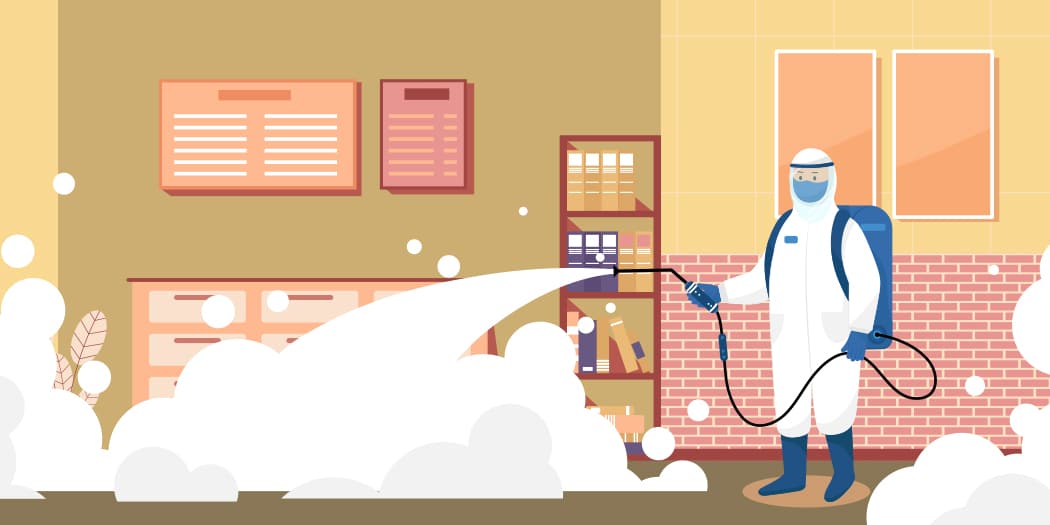Key Points
Types of Bloodborne Pathogens
OSHA Bloodborne Pathogen Standard
Implementing an Exposure Control Plan
Information and Training

A bloodborne pathogen (or BBP) is any type of living organism (usually microscopic) that can transmit potentially fatal illness in human blood. They are known for causing disease, infections, and more. Bloodborne pathogens are one of the largest concerns among the biohazard industry and healthcare community alike.
Coming into contact with a bloodborne pathogen could spell the difference between life long illness, life, and even death. That is why the government has proposed special procedures for handling these kinds of issues, all which professional company cleanup crews like Bio Recovery are trained to take care of.
You must not attempt to treat these situations on your own. They are extremely dangerous, which is why the OSHA Bloodborne Pathogen Standard has special procedures that must be followed to legally and safely restore the situation.
Types of Bloodborne Pathogens
Bloodborne pathogens are any type of living organism that can infect the blood. Naturally there’s a huge range. As a general rule of thumb, in any situation you find blood, you never want to assume it is free from potential pathogens. Mishandling a situation can lead to unintentional exposure, which can include lifelong illness, or sometimes death.
Contact with a BBP means potentially being exposed to pathogens such as enveloped or non enveloped viruses and infectious diseases like MRSA. Some of the other examples of BBP include:
- Malaria
- Syphilis
- Hepatitis B, C, and D
- HIV
- Ebola
When you think of OSHA, you may think of worker rights and workplace safety. However, OSHA legislation also protects public safety–regardless of whether or not the person is working. To ensure protection against these serious diseases, federal organizations such as OSHA and the EPA have specific regulations.
OSHA Bloodborne Pathogen Standard
OSHA regulations consider bloodborne pathogens (or BBP) biohazardous waste, which means these situations follow similar protocol with a BBP standard. A team will wear PPE and follow a procedure under OSHA requirements. The procedure usually involves:
- Identifying the situation
- Recognizing all biohazards (including the BBP)
- Drafting a Standard Operating Procedure (SOP)
- Wearing the proper PPE
- Using an ATP test to test the area multiple times and treat the contaminants accordingly
- Controlling and preventing further contamination by properly setting up work zones
- Decontaminating areas and equipment using EPA-registered disinfectants
- Implementing an exposure control plan
- Properly disposing of regulated waste in closable containers (1910.1030(d)(4)(iii)(B)(1)(i)) properly labeled (1910.1030(d)(4)(iii)(B)(1)(iii)) and color coded.
OSHA’s official definition for “regulated waste” includes:
- liquid or semi-liquid blood or other potentially infectious materials
- contaminated items that would release blood or other potentially infectious materials in a liquid or semi-liquid state if compressed (urine samples and pregnancy tests are not included in this unless there is blood present)
- items that are caked with dried blood or other potentially infectious materials and are capable of releasing BBP or OPIM (other potentially infectious materials) during handling
- contaminated sharps
- pathological and microbiological wastes containing blood or other potentially infectious materials.
Furthermore, OSHA requires that at least one supervisory level technician be on site where BBP may be present (1910.120 App C).
Implementing an Exposure Control Plan
An exposure control plan helps eliminate or minimize BBP contact and exposure. OSHA requires each work site to have an exposure control plan. A plan typically consists of:
- Methods of Compliance
- Equipment and Supplies
- Verified HIV and HBV Testing
- Hepatitis B Vaccination and Post-Exposure Evaluation and Follow-up
- Communication of Hazards to Employees
- Recordkeeping
An exposure control plan needs to be reviewed and updated annually as technology, regulations, company procedures, and staff responsibilities change (1910.1030(c)(1)(iv)). While these regulations mostly apply for medical settings where technology is constantly developing, a professional biohazard cleaning company should be on top of cutting edge technology.
Methods of Compliance
Methods of Compliance refers to how the crew will comply with regulations. In hospital or medical clinic settings, the Methods of Compliance will contain exposure determination, or which staff handle which responsibilities, from handling potentially contaminated linens to wiping down surfaces. This subset of regulations include following the Bloodborne Pathogens Standard for “universal precautions” which assumes all bodily fluids are potentially pathogenic (potentially positive for HIV, HBV, and other infectious diseases) (29 CFR 1910.1030(b)).
Universal precautions require that proper PPE is worn to prevent contact with blood or other potentially infectious materials (29 CFR 1910.1030(d)(1)). Determining the correct PPE requires an experienced licensed personnel to evaluate hazards. Correct PPE is required to be provided by the licensed company (or in the case of a medical setting, the employer).
HIV and HBV
As already mentioned, BBP can contain hundreds of infectious diseases, not just HIV and HBV (Hepatitis B). However, due to the high contagion and risk of HIV and HBV cases, OSHA has issued special regulations for HIV and HBV exposure. For example, in a HIV or HBV research laboratory environment, OSHA requires containment equipment depending on the biosafety level (1910.1030(e)(2)(iii)).
OSHA also has specific regulations for HBV vaccinations. Employers and companies are required to make the hepatitis B vaccine and vaccination series available to anyone that may have exposure. The vaccine should be accessible at no cost and administered by a licensed healthcare professional and/or doctor. Post-exposure evaluation and follow up is a part of this process, as regulated in 1910.1030(f)(3). This involves documenting the exposure, testing for the virus, sending the results to the individual, and a confidential follow up.
Communication of Hazards to Employees
OSHA mandates that container or hazardous sites must be affixed with appropriate labels and signage. Certain labels, containers, and signs must be a certain color combination (1910.1030(g)(1)(i)(C)). Biohazard work sites require signage at the front and in laboratory environments.
Recordkeeping
Recordkeeping involves the documentation of medical records, which must have the name of the employee, a copy of their hep B vaccination status, test results, and follow-up procedures. All records must be kept confidential.
Information and Training
Whenever a staff member, including a bio cleaning crew, may encounter BBP, thorough information and training sessions must be provided annually (1910.1030(g)(2)(iv)). The sessions are required to inform about the OSHA Bloodborne Pathogen Standard and include information about the HBV vaccine, as well as basic information about the PPE. Employers are required to keep training records for up to 3 years. Sessions are required whenever a staff member may come into contact with a BBP.
If you are looking for a career in crime scene cleaning, OSHA requires these information and training sessions are paid for by the licensed biohazard company hiring you.
If you are currently dealing with this situation, Bio Recovery hopes this article has helped you understand the specific federal regulations surrounding these types of clean ups. Do not attempt to clean any area if you do not have an experienced and licensed biohazard supervisor on site.
Who We Are
Overestimating your ability to take on these type of situations is not just a huge health risk to you but the surrounding public as well. The good news is Bio Recovery is a fully OSHA compliant and certified professional biohazard company with over 20 years experience.
Bio Recovery crews have complete 24 hour and 40 hour HAZMAT and HAZWOPER certification courses annually to stay up to date on the latest safe cleaning, restoration, removal, and transportation procedures. Furthermore, most situations are considered “no fault” and completely covered by insurance, so there is no cost to you.
Please do not hesitate to contact us at any time, 24/7, for immediate assistance.
Share this Post
